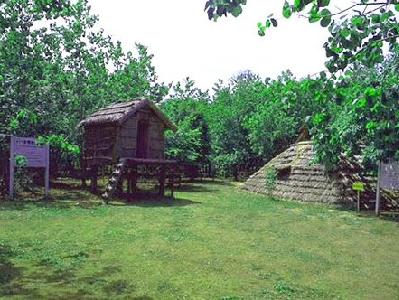|
About 7 kilometers from Monbetsu on the Omusaro Plateau in Hokkaido, are the remains of pit dwellings. These remains spread over a hill between Shokotsu River and Omusaro Pond near the town of Okoppe. There are 208 pit dwellings of early native peoples extending for about 1km in this area.
These remains probably belong to the early Jomon period of about 10,000 years ago. There are also remains belonging to the later Satsumon period that feature the unique Okhotsk culture of the Ainu people of Hokkaido. These pit dwellings show us the life of these peoples over a period of 10,000 years.
Today, the remains are part of a park on the plateau, and there is a great view from the top. There has been some restoration of the pit dwellings, and of high-floored warehouses which give a feeling of life in the Satsumon period 1,000 years ago. Plants favored by the Ainu people, such as 'oubayuri', 'ezoengosaku' and 'gyojaninniku' have been planted in the area.
These remains probably belong to the early Jomon period of about 10,000 years ago. There are also remains belonging to the later Satsumon period that feature the unique Okhotsk culture of the Ainu people of Hokkaido. These pit dwellings show us the life of these peoples over a period of 10,000 years.
Today, the remains are part of a park on the plateau, and there is a great view from the top. There has been some restoration of the pit dwellings, and of high-floored warehouses which give a feeling of life in the Satsumon period 1,000 years ago. Plants favored by the Ainu people, such as 'oubayuri', 'ezoengosaku' and 'gyojaninniku' have been planted in the area.
| [+ADDRESS] | 
|













